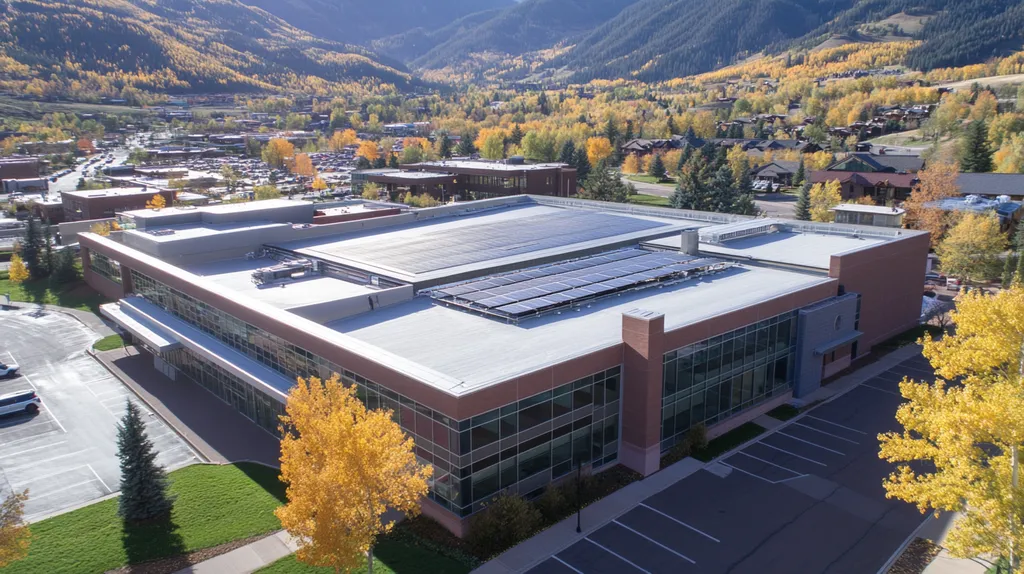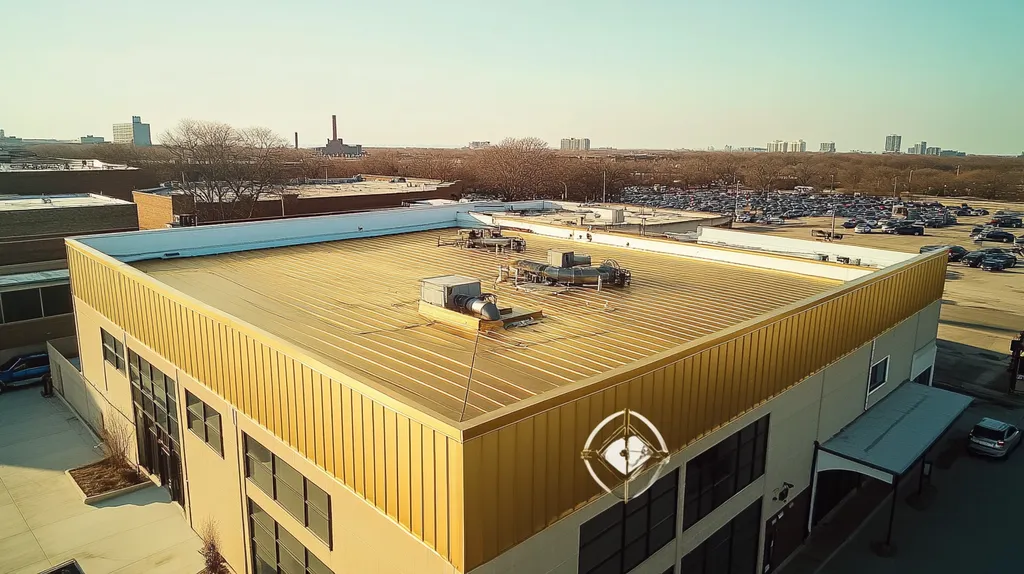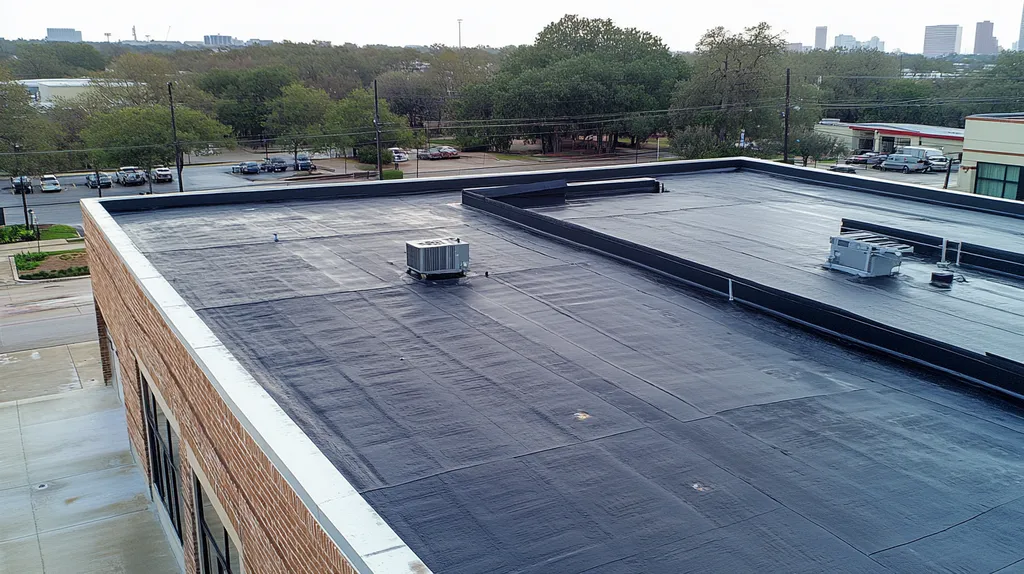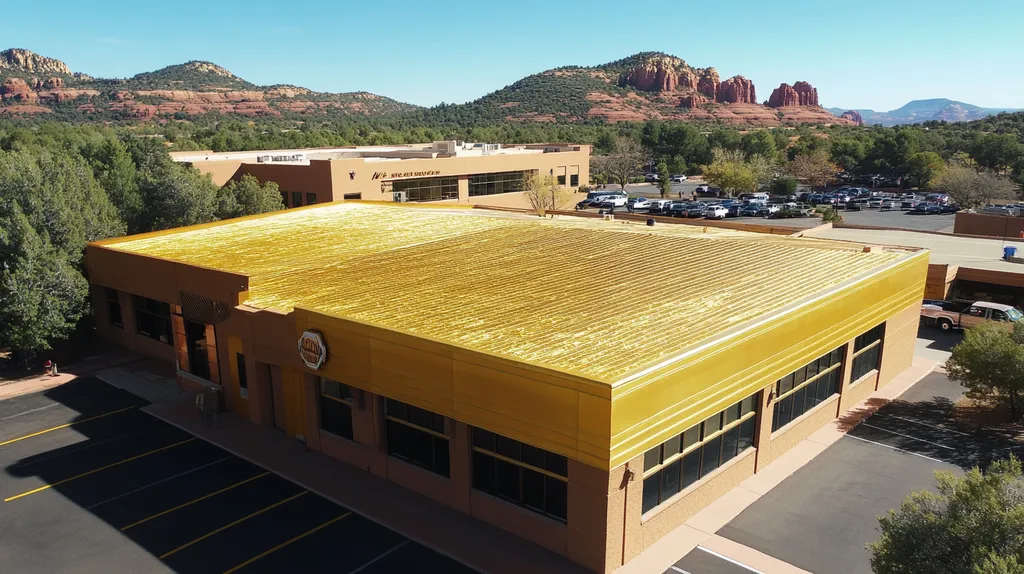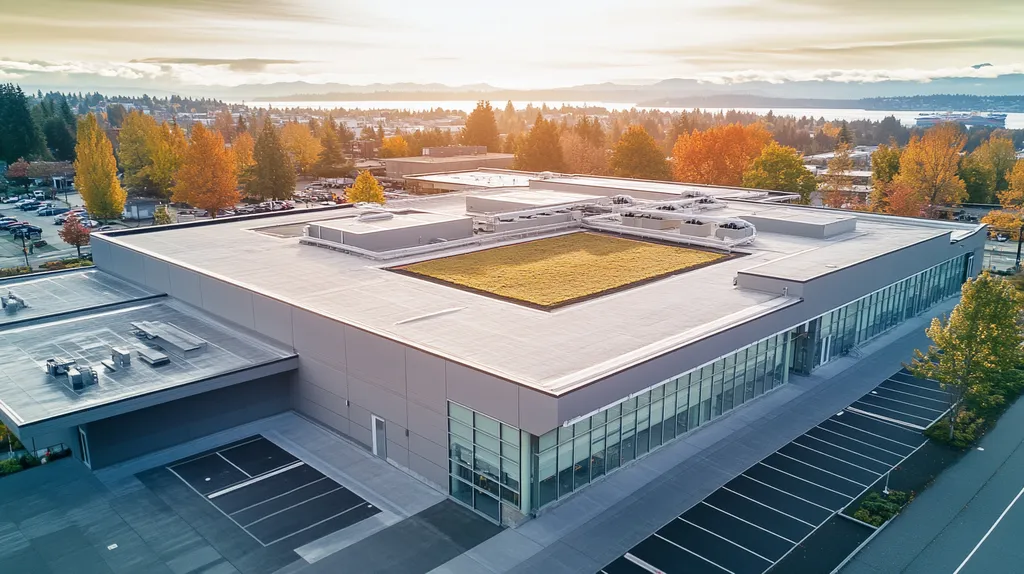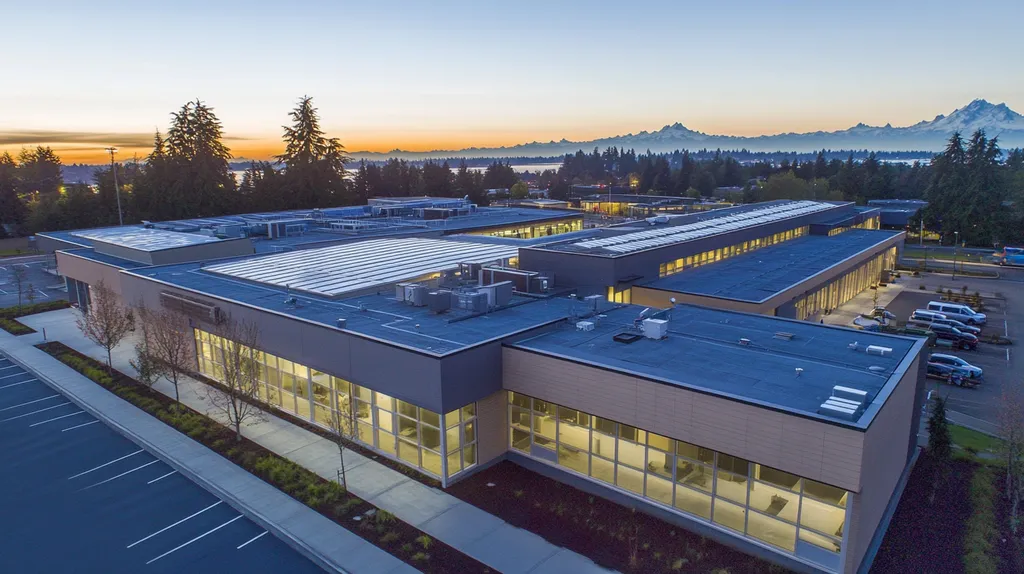Commercial building owners lose up to 30% of their cooling costs through inefficient roofing systems that absorb rather than reflect solar energy. With energy prices rising 5-7% annually, this waste translates to thousands of dollars in preventable expenses.
Reflective roof coatings offer a proven solution, reducing roof surface temperatures by up to 60°F and cutting cooling costs by 10-30% in most buildings.
This comprehensive guide examines the science behind reflective coatings, proper installation methods, and optimization strategies that maximize both energy savings and roof protection.
SECTION 1: FUNDAMENTAL CONCEPTS
Commercial building owners face mounting pressure to reduce energy costs while meeting sustainability goals. With energy expenses representing up to 30% of a building’s operating budget, the roof plays a critical role in efficiency. Traditional dark roofing materials can reach temperatures of 150°F or higher on sunny days, forcing cooling systems to work harder and driving up costs. Understanding how reflective coatings work and their impact on building performance is essential for making informed roofing decisions.
Principles of Solar Reflectivity and Emissivity
A cool roof is designed to reflect more sunlight than a conventional roof, absorbing less solar energy and lowering the temperature of the building. (source: U.S. Department of Energy)
Solar reflectivity measures how effectively a surface bounces solar radiation back into the atmosphere rather than absorbing it as heat. The most effective reflective coatings can reflect up to 85% of incoming solar radiation.
Emissivity represents how readily a surface releases absorbed heat. Higher emissivity values mean faster heat release, preventing heat buildup in the building structure.
Together, these properties determine a roof’s ability to maintain lower surface temperatures. The best performing coatings combine high reflectivity with high emissivity to maximize cooling benefits.
Thermal Impact of Reflective Roof Coatings
Surface temperatures on traditional dark roofs can exceed ambient air temperature by up to 90°F during peak summer conditions. Reflective coatings can reduce this temperature differential by 50-60°F.
This dramatic temperature reduction directly impacts the building envelope’s heat load. Less heat entering through the roof means reduced strain on air conditioning systems.
The coating’s thermal performance remains relatively stable over time, though regular cleaning helps maintain optimal reflection rates. Even with some degradation, reflective coatings continue providing significant temperature reduction benefits for years.
Building materials beneath the coating also benefit from reduced thermal stress, potentially extending the roof system’s lifespan by 5-10 years.
Energy Efficiency Benefits for Commercial Buildings
Cooling energy savings from reflective coatings typically range from 10-30% depending on building design, climate zone, and existing insulation levels. These savings translate directly to lower utility bills and reduced peak demand charges.
The reduced cooling load allows HVAC systems to operate more efficiently and may enable downsizing of replacement equipment. This creates additional cost savings beyond direct energy reduction.
Many utilities and government agencies offer rebates or incentives for reflective roof installations, improving project ROI. These programs often cover 15-30% of material and installation costs.
Beyond energy savings, reflective coatings contribute to sustainability goals by reducing carbon emissions and urban heat island effects. This helps organizations meet environmental commitments while improving their bottom line.
SECTION 2: SYSTEM COMPONENTS
Today’s commercial property owners face a critical challenge: aging roofing systems are driving up cooling costs by 25-40% compared to buildings with modern reflective coatings. The components that make up these coating systems directly impact both short-term energy savings and long-term building performance. Making informed decisions about coating materials, primers, and protective additives has become essential for maintaining competitive operating costs.
Types of Reflective Coating Materials and Formulations
The commercial roofing market offers three primary coating categories: acrylics, silicones, and polyurethanes. Each material serves distinct purposes and delivers specific benefits for energy efficiency applications.
Acrylic coatings provide excellent UV resistance and reflectivity at a lower cost point. These water-based formulations offer easy application and maintenance, making them ideal for buildings in moderate climates with standard foot traffic.
Silicone coatings excel in extreme weather conditions and deliver superior waterproofing. Their moisture resistance and flexibility make them particularly effective for buildings in high-rainfall regions or structures with minimal slope.
Polyurethane options offer the highest durability and abrasion resistance. These coatings maintain their reflective properties even under heavy maintenance traffic and are optimal for roofs requiring frequent access.
Substrate Compatibility and Primer Selection
The effectiveness of reflective coatings depends heavily on proper adhesion to the existing roof surface. Different substrates require specific preparation techniques and primer selections to ensure maximum coating performance.
Metal roofs typically need rust-inhibiting primers that both protect the substrate and promote coating adhesion. Built-up and modified bitumen surfaces often require specialized primers to prevent bleed-through and ensure proper bonding.
Single-ply membranes like TPO and EPDM demand careful surface preparation and compatible primers. Improper primer selection can lead to coating delamination and premature system failure.
Surface contamination and moisture content must be addressed before primer application. Even minor oversights in substrate preparation can significantly reduce both coating adhesion and energy efficiency benefits.
Additives and Enhancements for UV and Moisture Resistance
Modern coating systems incorporate specialized additives that enhance durability and maintain reflective properties over time. These components play a crucial role in sustaining energy efficiency benefits throughout the coating’s service life.
UV-resistant additives like titanium dioxide particles help maintain surface reflectivity. These microscopic components scatter solar radiation and prevent coating degradation, preserving the system’s energy-saving properties.
Moisture-resistant additives create stronger molecular bonds within the coating matrix. This enhanced structure helps prevent water infiltration and maintains coating integrity even under ponding conditions.
Elastomeric additives allow coatings to expand and contract with temperature fluctuations. This flexibility prevents cracking and delamination, ensuring consistent performance across seasonal changes.
Biocides and fungicides protect against biological growth that can compromise reflectivity. Regular maintenance combined with these protective additives helps maintain optimal energy efficiency performance.
SECTION 3: IMPLEMENTATION METHODS
Commercial building owners lose millions annually through improper reflective coating installation. Studies show that 40% of coating failures stem from inadequate surface preparation, while another 35% result from poor application techniques. With energy costs climbing 5-7% yearly, proper implementation of reflective coatings has become critical for maintaining competitive operating expenses and achieving projected efficiency gains.
Surface Preparation and Roof Inspection Protocols
Successful coating projects begin with comprehensive roof assessments that identify structural issues, moisture infiltration, and substrate deterioration. These evaluations must include core sampling to verify existing roof composition and moisture content.
Surface cleaning requires more than simple pressure washing. Contractors must remove all contamination, including invisible residues that can compromise adhesion. This typically involves specialized detergents and mechanical scrubbing.
Moisture detection using infrared scanning helps identify wet insulation and substrate areas requiring replacement. Even minor trapped moisture can cause coating blistering and delamination.
Proper repairs to seams, flashings, and penetrations must precede coating application. These areas represent the highest risk for future leaks and coating failure.
Techniques for Coating Application and Layering
Application methods must match both the coating type and environmental conditions. High-solids coatings typically require airless spray equipment, while lower-viscosity materials can be rolled or brushed.
Temperature and humidity significantly impact coating performance. Application should occur when substrate temperature is at least 5°F above dew point to prevent moisture condensation.
Proper millage control ensures uniform coverage and optimal reflectivity. Regular wet film thickness measurements during application prevent material waste while guaranteeing adequate protection.
Detail work around protrusions requires special attention and often manual application methods. These areas need reinforcement with fabric or additional coating layers.
Curing Times and Quality Assurance Practices
Different coating types have distinct curing requirements based on chemical composition and environmental conditions. Ambient temperature, humidity, and air movement all affect curing rates.
Quality control inspections must occur throughout the curing process. Key checkpoints include adhesion testing, dry film thickness measurements, and visual inspection for surface defects.
Protection of newly coated surfaces from traffic and contamination is essential during curing. Temporary barriers and warning signs help prevent damage from maintenance activities.
Final inspections should include reflectivity testing to verify energy performance metrics. This data provides baseline measurements for future maintenance comparisons.
SECTION 4: MAINTENANCE REQUIREMENTS
Commercial property owners face a critical maintenance challenge: poorly maintained reflective coatings can lose up to 35% of their energy-saving potential within the first two years. This degradation translates to thousands in unnecessary cooling costs and accelerated roof deterioration. Without proper maintenance protocols, even the highest-quality coating installations fail to deliver their promised efficiency gains, compromising both operational budgets and sustainability goals.
Routine Inspection and Cleaning Procedures
A cool roof is designed to reflect more sunlight than a conventional roof, absorbing less solar energy and lowering the temperature of the building. However, this performance depends entirely on maintaining the coating’s reflective properties through regular care. (source: U.S. Department of Energy)
Quarterly inspections should focus on high-traffic areas, drainage paths, and mechanical equipment zones where coating damage most frequently occurs. These vulnerability points require detailed documentation and photography to track changes over time.
Professional cleaning must occur at least twice annually using low-pressure washing systems and pH-neutral cleaners. Harsh chemicals and abrasive cleaning methods can permanently damage coating surfaces, reducing their reflective capabilities.
Between scheduled cleanings, maintenance teams should remove visible debris monthly and document any areas showing premature wear or contamination. This ongoing monitoring helps prevent small issues from escalating into major repairs.
Repairing Coating Damage and Seam Reinforcement
Surface damage requires immediate attention using manufacturer-approved repair materials and techniques. Even minor scratches or punctures can compromise the coating’s protective properties and lead to substrate deterioration.
Seam repairs demand special attention to maintain watertight integrity. Reinforcement fabrics must extend at least 6 inches beyond damaged areas, with proper feathering of coating materials to prevent water infiltration.
Flashing details and roof penetrations need regular inspection and maintenance to prevent coating separation. These high-stress areas often require additional reinforcement layers to maintain long-term performance.
Documentation of all repairs should include material types, application methods, and weather conditions during installation. This information proves invaluable for warranty claims and planning future maintenance.
Longevity and Recoating Intervals
Most reflective coatings maintain peak performance for 7-10 years with proper maintenance. However, severe weather exposure and mechanical damage can significantly reduce this lifespan.
Annual reflectivity testing helps determine optimal recoating timing. When measurements show a 20% reduction in reflective properties, facility managers should begin planning for reapplication.
Recoating projects require careful coordination with building operations. The process typically takes 3-5 days, depending on weather conditions and coating type selected.
Strategic timing of recoating work can maximize energy savings. Applications completed in early spring allow proper curing before peak cooling season, ensuring maximum efficiency benefits.
SECTION 5: PERFORMANCE METRICS
Commercial building owners waste millions annually by failing to track and optimize reflective coating performance. Studies show that poorly monitored coatings can lose up to 40% of their reflective capacity within three years, dramatically reducing energy savings. Without proper performance measurement and verification, even premium coating installations fail to deliver their promised efficiency gains, leading to inflated cooling costs and shortened roof system lifespans.
Measuring Solar Reflectance and Thermal Emittance
Solar reflectance indexes provide critical baseline data for evaluating coating effectiveness. Initial measurements should establish benchmark values for both new installations and existing surfaces to track performance changes over time.
Field testing equipment must be properly calibrated and operated under standardized conditions. Environmental factors like temperature, humidity, and solar intensity can significantly impact measurement accuracy.
Thermal emittance testing reveals how effectively coatings release absorbed heat rather than transferring it into the building. Higher emittance values indicate better thermal management properties.
Regular performance monitoring helps identify areas needing maintenance or recoating before efficiency losses impact operating costs. Quarterly measurements provide the most reliable tracking data for system optimization.
ASTM and Cool Roof Rating Council Standards
Compliance with ASTM D6083 standards ensures coating formulations meet minimum requirements for adhesion, elongation, and weathering resistance. These specifications provide crucial quality benchmarks for material selection.
The Cool Roof Rating Council’s product rating program validates manufacturer performance claims through independent laboratory testing. This third-party verification helps prevent exaggerated efficiency promises.
Initial and aged reflectance values must meet minimum thresholds for Energy Star certification. These requirements vary by roof slope and building type to ensure appropriate performance targets.
Documentation of testing methods and results supports warranty claims while demonstrating regulatory compliance. Proper record-keeping becomes especially critical for buildings in jurisdictions with energy efficiency mandates.
Impact on Building Energy Consumption and HVAC Load
A cool roof is designed to reflect more sunlight than a conventional roof, absorbing less solar energy and lowering the temperature of the building. This reduced heat gain directly impacts HVAC system performance and energy consumption. (source: U.S. Department of Energy)
Peak cooling load reductions of 10-30% are typical for buildings with properly maintained reflective coatings. These savings compound during extreme heat events when utility rates often surge.
Reduced thermal stress on HVAC components extends equipment service life while lowering maintenance costs. Systems operating at lower capacity experience fewer mechanical failures and require less frequent repairs.
Energy modeling software can predict cost savings based on coating performance metrics. These projections help justify coating investments while establishing realistic efficiency targets.
SECTION 6: OPTIMIZATION STRATEGIES
Commercial building owners are losing millions in potential energy savings through suboptimal reflective coating strategies. Industry data shows that poor coating optimization can reduce energy efficiency by up to 40%, while increasing cooling costs by $2-3 per square foot annually. Without a comprehensive optimization approach that considers coating selection, system integration, and lifecycle costs, even premium installations fail to deliver their full potential for both energy savings and roof protection.
Enhancing Reflectivity with Coating Selection and Color
Material selection directly impacts coating performance and longevity. Premium-grade silicone and acrylic formulations maintain up to 85% reflectivity after three years, while economy products often degrade below 60% within 18 months.
Color selection requires balancing aesthetics with performance. White and light gray coatings typically achieve 80-90% solar reflectance, while tan and beige options range from 65-75%.
Regional climate conditions should guide coating choices. Hot, sunny regions benefit most from maximum reflectivity, while moderate climates may achieve adequate performance with mid-range products.
Application thickness significantly affects long-term performance. Multiple thin layers typically outperform single thick applications, providing better adhesion and more uniform coverage.
Integration with Roof Insulation and Ventilation Systems
Reflective coatings perform best when integrated with proper insulation systems. Every R-value point improvement in roof insulation amplifies coating effectiveness by 5-8% through reduced heat transfer.
Ventilation pathways must remain unobstructed for optimal performance. Blocked or restricted air flow can reduce coating efficiency by up to 25% while accelerating material degradation.
Strategic placement of roof penetrations and equipment can preserve coating integrity. Clustering mechanical systems minimizes coating disruption while simplifying maintenance access.
Proper flashing details around penetrations prevent coating failure points. Reinforced coating applications at these transitions maintain system performance while reducing maintenance needs.
Lifecycle Cost Analysis and Sustainability Considerations
A cool roof is designed to reflect more sunlight than a conventional roof, absorbing less solar energy and lowering the temperature of the building. The initial investment typically returns 15-30% annually through reduced cooling costs. (source: U.S. Department of Energy)
Regular performance monitoring helps optimize maintenance timing. Tracking reflectivity changes allows facility managers to schedule recoating before efficiency losses impact operating costs.
Environmental benefits extend beyond direct energy savings. Reduced cooling demand decreases carbon emissions while minimizing urban heat island effects.
Many jurisdictions offer tax incentives and rebates for reflective coating installations. These programs can offset 20-35% of project costs while accelerating return on investment.
The Bottom Line
With energy costs rising 5-7% annually, commercial buildings can no longer afford inefficient roofing systems that waste up to 30% of cooling expenses.
Reflective coatings represent a proven solution, delivering 10-30% energy savings while extending roof life by 5-10 years when properly implemented.
Success requires careful attention to material selection, installation quality, and ongoing maintenance protocols to maintain peak performance.
The return on investment is clear: buildings utilizing optimized reflective coating systems save an average of $2.50 per square foot annually in cooling costs while supporting sustainability goals.
For facility managers seeking both immediate savings and long-term value, reflective roof coatings have become an essential component of modern building performance strategies.
FREQUENTLY ASKED QUESTIONS
Q. How do reflective coatings improve commercial roof efficiency?
A. Reflective coatings reflect sunlight, reducing heat absorption and lowering roof temperatures. This enables cooling systems to operate more efficiently, directly affecting energy costs and comfort levels within the building.
Q. What are the best components for an industrial roof coating?
A. High-quality reflective coatings such as acrylics, silicones, or polyurethanes are essential. Each material provides unique benefits depending on the climate, roof type, and specific performance needs.
Q. What are the correct methods for applying coatings to commercial roofs?
A. Surface preparation is vital for effectiveness. Proper application may involve spraying, rolling, or brushing, adhering to the climate and material specifications to ensure optimal performance and durability.
Q. How often should I maintain my reflective coatings on commercial roofs?
A. Regular maintenance is crucial, with inspections every quarter and professional cleanings at least twice a year. This keeps the reflective properties intact and addresses minor damages early to prevent major issues.
Q. What performance metrics should I track for my commercial roof?
A. Track solar reflectance and thermal emittance regularly. Monitoring these metrics allows for timely maintenance and helps verify energy efficiency, ensuring your roofing system is functioning optimally.
Q. Which optimization strategies can enhance energy efficiency for commercial roofs?
A. Focus on material choice, proper application thickness, and integrating insulation. A well-optimized roof maximizes reflective properties and minimizes overall energy costs, significantly improving system longevity.
Q. What are the financial benefits of reflective coatings for commercial roofs?
A. Reflective coatings can lead to reduced utility bills, potentially saving 10-30% on cooling costs. Many programs also offer incentives that further improve ROI while contributing to sustainability goals.

